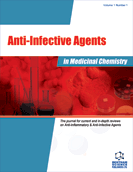Abstract
Bacterial biofilms are defined as a surface attached community of microorganisms that are protected by an extracellular matrix of biomolecules. Within a biofilm state, bacteria are more resistant to antibiotics and are inherently insensitive to antiseptics and basic host immune responses. The NIH has estimated that 65-80% of all microbial infections are biofilm-based. Biofilm infections of indwelling medical devices are also of major concern, as once the device is colonized, infection is virtually impossible to eradicate. Bacterial biofilms underlie the persistent colonization of hospital facilities, which perpetuates nosocomial infections. Hospital-acquired infections place a $10 billion burden on the U.S. healthcare system annually. Given the prominence of biofilms in infectious diseases, there has been an increasing effort toward the development of small molecules that will modulate bacterial biofilm development and maintenance. This, coupled with the spread of multi-drug antibiotic resistance across many of these bacteria, has put a tremendous burden on the scientific and medical community to alleviate biofilm-related problems. In this review, we will highlight the development of small molecules that inhibit and/or disperse bacterial biofilms through non-microbicidal mechanisms. The review will be segmented into providing a general overview of how bacteria develop into biofilm communities, why they are important, and the difficulties associated with their control. This will be followed by a discussion of the numerous approaches that have been applied to the discovery of lead small molecules that mediate biofilm development. These approaches are grouped into: 1) discovery/synthesis of molecules based upon naturally occurring bacterial signaling molecules, 2) chemical library screening, and 3) discovery/synthesis of natural product and natural product analogues.
Keywords: Biofilm, bacteria, non-microbicidal, medicinal chemistry, biological activity, structure-activity-relationship, natural products
 15
15





















